February 22nd–26th 2013
I made my first visit to Colonial Williamsburg (or CW as it is known) in 1994 to attend the conference on Painted Wood: History and Conservation
It was a memorable event and, twenty years later, I can still remember a couple of the papers, especially Elizabeth White’s one entitled Perished Perches: The Evidence for English Painted Wooden Furniture in Eighteenth-Century Gardens. To this day I can summon up from the back of my brain some of the images that she used.
During that week there were plenty of opportunities to look at the historical buildings in Colonial Williamsburg. In fact, when my interest in paint analysis was understood the curatorial department showed me a number of the projects that they were working on and I learnt much about colours and finishes in Colonial America. Fortunately my visit coincided with an investigation being carried out on the exterior of one of the wooden-sided houses by the great American paint analyst, Frank Welsh, and I was able to join him for an afternoon.
It was on that visit that any notions that I might have harboured about Colonial Williamsburg being merely a ‘Disney’ type experience were knocked into a three-cornered hat. I was struck by the professionalism of the team and the willingness to listen to someone with far less museum experience but a little knowledge of paint. For the last twenty years we have remained in touch and I have been back several times to lecture and to look at some of their more recent projects. The incredible thing is that after all these years four of the five-strong team are still working at Colonial Williamsburg. There cannot be many institutions with such long-serving staff.
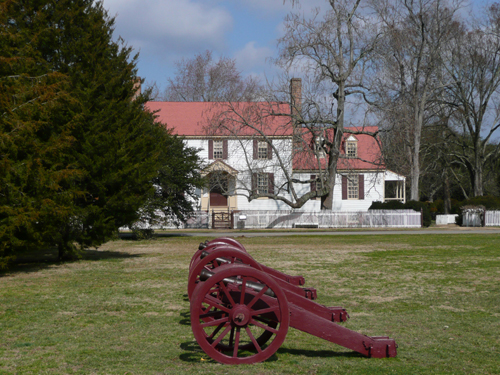
I was therefore delighted to be asked to speak at the 65th Colonial Williamsburg Antiques Forum, which I understand is the biggest such forum (and certainly the oldest) held in the United States. In 2012 I had been invited to give the keynote address at the Charleston Art & Antiques Forum and such was the interest shown in my work as a paint detective that I developed that theme.
The programme was a full one and I had decided beforehand that as well as attending certain of the lectures I also wanted to spend as much time as possible looking at various of the historic houses and catching up on their latest decorative treatment.
As John Harris has so wisely said:
“The problem at Colonial Williamsburg, as indeed anywhere else, is that each successive restoration is reflective of its time”1
The approach to colour has changed as analytical techniques have developed and many of the colours that were being applied in the 1990s have now been changed. This is a theme that I will return to in a future post.
The Forum
On the first day my wife and I joined the bus trip to the Northern Neck with Ralph Harvard (antiquarian and interior designer) and Matt Webster (Director of Historic Architectural Resources at CW) to study several structures dating from the 1730s to the 1760s. This represented the experimental period of Virginia design before the staid Georgian style swept across the Old Dominion. These buildings are distinguished by bold decoration and superb craftsmanship unrivalled in colonial America and represent the most European aspects of any structures built in the colonies.
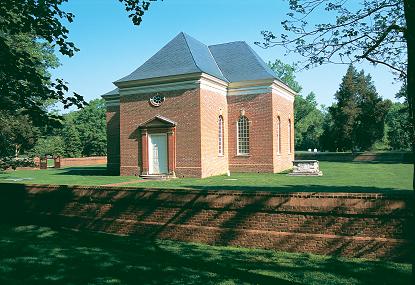
The first stop was at Christ Church. Finished in 1735, it was the most finely crafted Anglican parish church in all of colonial Virginia and is one of the most important examples of Georgian architecture in America. Another early church that we visited was St Mary’s Whitechapel, which was founded in 1669. The monuments in the cemetery record the names of many of Lancaster County and Virginia’s prominent citizens. After an excellent lunch we moved on to Sabine Hall, which was built by Robert (‘King’) Carter of Corotoman, for his son Landon, in 1730. It is situated on the hills a mile from the Rappahannock River and commands a great view of the river and much of the four-thousand-acre estate. The five-layered terraced garden at the rear was laid out by an English gardener when the house was built.
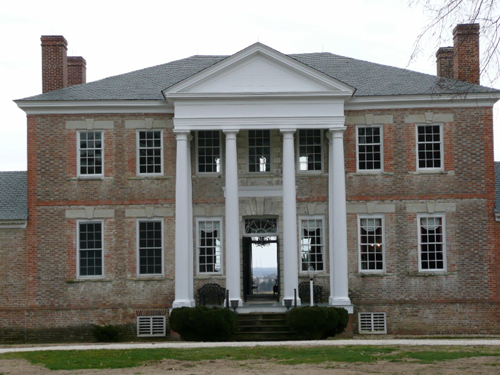
The house and the wings are built of brick. The main building has a front portico the pediment of which is supported by four large cypress columns. Entrance is made through heavy doors into a broad hall, which runs from front to rear and opens through similar doors on to a covered porch which extends along the entire rear of the main building. Over the entrance to a side hall is an arch through which one passes to an elegant staircase. The halls, as well as the parlour, dining room and most of the bedrooms, are panelled from floor to ceiling.
That evening we attended the opening reception and met many of the other delegates, some of whom had also been at the Charleston Antiques Forum the year before. This was followed by one of many parties during our time in Williamsburg.
The Second Day began with a welcome and an introduction by Colin G. Campbell, president and CEO of The Colonial Williamsburg Foundation.
The Gracia and Horatio Whitridge Distinguished Scholar lecture was given by Robert Leath, an old friend from an earlier project at the Nathaniel Russell House in Charleston, South Carolina.
Robert is now vice president for collections and research, the Museum of Early Southern Decorative Arts (MESDA) at Winston-Salem in North Carolina. His talk was entitled Scarlett has an iPad: New Directions in Southern Decorative Arts and looked at the many digital tools that have made it possible to link data, make new discoveries and present information to a wider audience. Robert is an accomplished and entertaining speaker and rightly deserved this key slot.
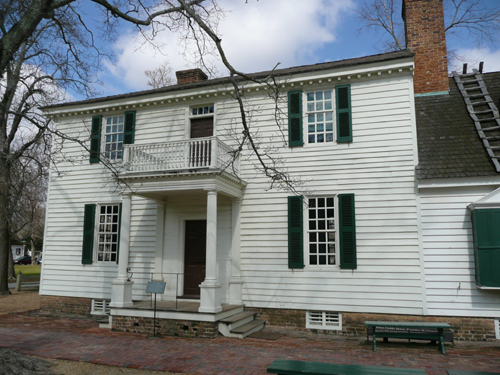
We took the opportunity to meet up with Kirsten Travers, an old intern at Papers and Paints. Kirsten is now employed as a paint analyst at Colonial Williamsburg and is in seventh heaven. She showed us the results of her research at the James Geddy House, where she discovered a green glaze on the panelling in the Parlor and which she was helping to reinstate.
The rest of the day was spent visiting many other well-remembered houses, in particular the George Wythe House where I recalled lengthy discussions about the rightness or wrongness of hanging wallpaper below the chair rail.
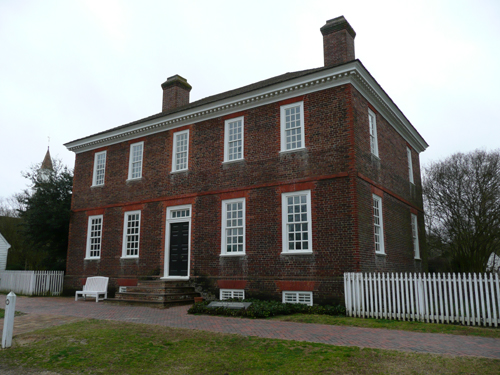
We also visited a number of the shops on Duke of Gloucester Street and spent a riveting time watching the mantua makers at work in Margaret Hunter’s Millinery.
One of the most interesting talks on the third day was entitled Patterns of Their Time: Design in Printed Textiles by Linda Eaton, director of collections and senior curator of textiles at Winterthur Museum, Garden & Library, Winterthur, Delaware. Linda spoke about the transatlantic trade in textiles and to my amazement used a slide of my 6th great grandfather, David Barclay, entertaining George III on the occasion of his visit to the City for the Lord Mayor’s Show in 1761. Barclay was a Quaker who had begun life as a linen draper and started trading with the West Indies and New England before becoming the founder of Barclays Bank. Needless to say we continued the discussion later.
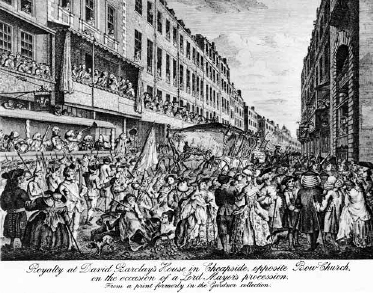
Once again, taking time off from the Forum, we dropped into Bruton Parish Church and had a very interesting tour of this 1715 building before visiting the Governor’s Palace to look at the newly-hung crimson damask in a first floor room.
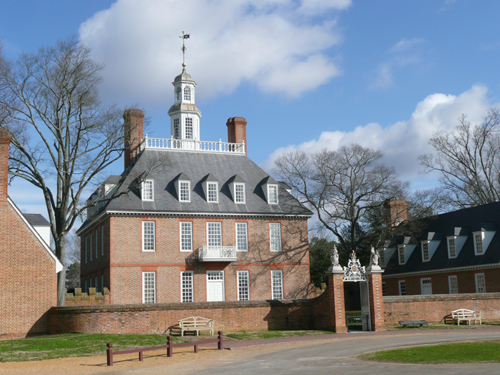
We then met up with a longstanding Twitter friend, Susan Holloway Scott, the author of historical fiction. She knows Williamsburg well and we revisited the mantua makers and watched a sash window being made in the carpenters’ shop.
In the evening we were invited to an excellent BBQ generously provided by Northeast Auctions and held in Shield’s Tavern. I understand that this is an annual event and Northeast Auctions should be commended for their generosity.
The fourth day was a chance to hear two friends from the Charleston Forum speak. The first was
Elliot Bostwick Davis, from the Museum of Fine Arts, in Boston, who spoke about The Art of the Americas Wing at the Museum. David Houston, who had been chief curator, then spoke about Crystal Bridges: The Making of a New American Museum, in Arkansas.
In the afternoon Alexandra Alevizatos Kirtley, the Montgomery-Garvan Associate Curator of American Decorative Arts of the Philadelphia Museum of Art then entertained us with It’s all about the Dress: Upholstery on Early American Furniture. She pointed out that the rather stunning dress that she was wearing was a purchase necessary to illustrate her message, or that’s what she had told her husband.
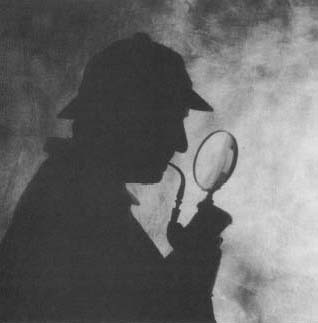
My talk, which was entitled The Paint Detective or the Columbo of Color, looked at three case studies where I had been able to establish far more than was expected of me by the clues provided by paint.
The first concerned a house in the centre of Dartmoor with a known Royal connection. I was able to demonstrate that two pairs of doors had originally hung in Carlton House, a building which had been demolished nearly 200 years ago. Furthermore, I could prove that they came from the Blue Velvet Closet.
In the second project I was able to date each of the 71 schemes applied to the exterior of a London house which was built in 1705 and use this information to provide an approximate date for each of the schemes on the interior panelling. I could show when the three narrow windows on the façade had been blocked up; the six-over-six sash windows hung and various alterations made to internal doorways.
I then described how I was able to reunite an early Georgian doorcase that had been found in an architectural salvage yard with the house from which it had been stolen – real Sherlock Holmes stuff!
I ended with an update on the restoration of the State Rooms at Stowe, where I have been working for the last four years.
Jeff Groff, the director of Public Programs at Winterthur Museum then gave a very interesting talk on how early American interiors were portrayed in the movies in a talk entitled Hollywood Historicism: The Colonial Revival in the Movies and Popular Media, 1920-60.
In the evening a reception was held in the Williamsburg Lodge Conference Center and this was followed by a dinner, which began with a couple of speeches and then the inimitable Ralph Harvard, who presented his customary and very witty poem mercilessly teasing the speakers and their talks. Fortunately I got off lightly.
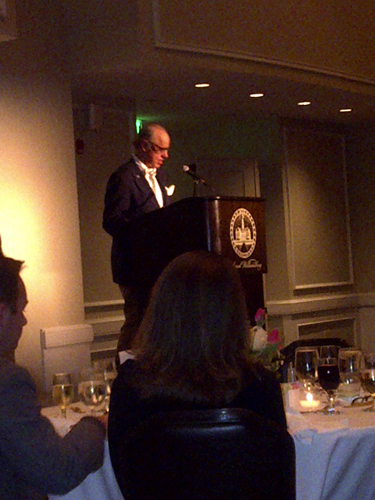
A small group of us had a real treat on the final day as we were given a tour of Colonial Williamsburg’s Architectural Collections at Packets Court. Matt Webster and Cynthia (Dani) Jaworski, architectural collections specialist at CW showed us the 6,000 square foot storage area where these artefacts are housed. The collection includes the finial of the Magazine; the steps of the second Capitol and the interior gutter from the Peyton Randolph House. At the same time we had the opportunity to study ornately carved English woodwork attributed to designers such as William Kent and Robert Adam, as well as carver Grinling Gibbons.
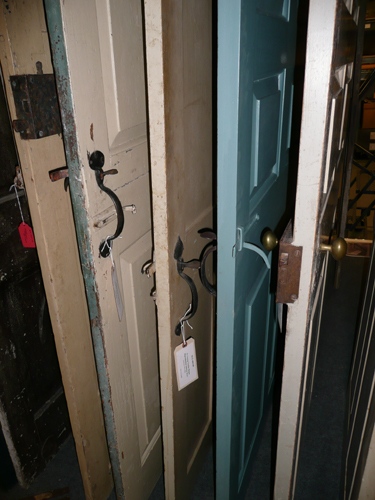
The afternoon was spent being given a solo tour of The Research Division, The John D. Rockefeller, Jr. Library and The Wallace Collections and Conservation Building with its incredible study collection, conservation laboratories and workshops.
We had an amazingly busy, informative and enjoyable week in Williamsburg. Roll on the 66th Colonial Williamsburg Antiques Forum.
I would like to thank all my old friends at CW but especially Ed Chappell, director of architectural research, and Susan Buck, one of America’s top paint analysts, for their hospitality and kindness during our time in Williamsburg.
NOTES
1 John Harris. Moving Rooms. Yale University Press. 2007 p.8.
View Larger Map













No comments yet. Be the first!